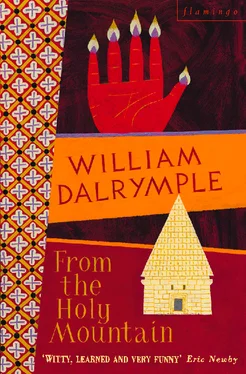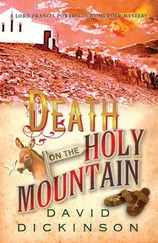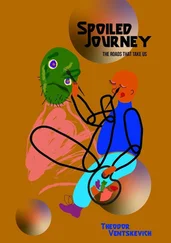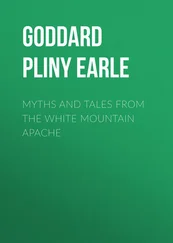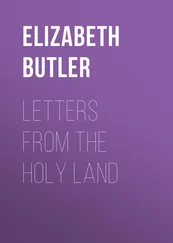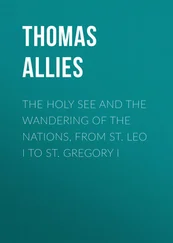1 ...8 9 10 12 13 14 ...30 The obelisk of the Emperor Theodosius still stands in the centre of the old racetrack, rising from the plinth where it was placed in the 430s. A carving on the side shows the cat’s-cradle of ropes and pulleys which was used to raise it. On another face is carved a picture of the Emperor in the imperial baldachin overlooking the races; these are illustrated at the base with a series of small relief carvings of what look like horse-drawn bathtubs.
Between the Emperor and the charioteers stand his bodyguard, a remarkably effeminate gaggle of fops with long floppy 1970s fringes, every bit as willowy as St John Damascene’s blood-and-fire sermons might have led one to expect. Certainly these gentle cosmopolitans not only look remarkably unthreatening, they appear to be much more interested in the races than in guarding the Emperor. Here could lie part of the explanation for the large number of successful assassination attempts in Byzantine history.
At the end of the Hippodrome, then as now, rises the great dome of Justinian’s Haghia Sophia, the supreme masterpiece of Byzantine architecture, and still, in the eyes of many, the most beautiful church ever built. No other Christian building is so successful in transporting one to the threshold of another world, or so dazzlingly intimates the imminence of the transcendent. In the golden haze of its interior, with its extraordinary play of light and space, precious stone and mosaic, under a dome that blazes like the vault of Heaven, even the solid walls seem to cease being barriers and become like passages into a higher reality. When it was first built in the 530s, Procopius, in one of his finest passages, described the overwhelming effect it has on the visitor. ‘So bright is the glow of the interior that you might say that it is not illuminated by the sun from the outside but that the radiance is generated within,’ he wrote in The Buildings . ‘Rising above is an enormous spherical dome which seems not to be founded on solid masonry, but to be suspended from heaven by a Golden Chain. Whenever one goes into this church to pray, one understands immediately that this work has been fashioned not by human power and skill, but by the influence of God. And so the visitor’s mind is lifted up to God and floats aloft, thinking that He cannot be far away, but must love to dwell in this place which He himself has chosen.’
The power of the building has not been diminished by fourteen hundred years of earthquakes and rebuildings, the destruction of much of its mosaic, the stripping of its altars, nor even a city fire which caused molten lead from the dome to run down the gutters in a flood of boiling metal. As you stand in the narthex you can see even the gossiping tour groups falling silent as they enter the dome chamber; if anyone talks they do so in a hushed whisper. The sacred breaks in on the mundane; and one immediately understands what a Byzantine monk must have felt when he touched a relic or gazed at a sacred icon: for a moment the gates of perception open and one catches a momentary glimpse of the Divine. Here, as nowhere else, one is transported back to the mental world of the Byzantium of John Moschos.
Yet the miraculous preservation of this one building – judged by the Byzantines themselves as their most perfect creation – can easily blind one to the amount that has been lost. Geography apart, John Moschos would not recognise much in this city if he came back today. Of the five hundred churches and monasteries which once decorated the land rising up from the Golden Horn, the remains of less than thirty survive, most of them rebuilt and converted into mosques.
This morning I visited the site of St Polyeuctes, once the greatest church in the whole Christian Empire; Justinian was said to have built Haghia Sophia in an attempt to match it. It would have been a familiar monument to John Moschos; indeed it was probably in a monastery attached to some great church like this that he lodged when he came to the city to finish The Spiritual Meadow .
The church fell into disrepair, and after the Turkish conquest of 1453 it collapsed and was forgotten. In 1960 it was accidentally rediscovered. Briefly it became famous again, and art historians and archaeologists triumphantly announced that many of the innovations of Justinian’s reign were pre-empted by the work at St Polyeuctes.
Thirty years later the various archaeological reports are gathering dust, and St Polyeuctes seems to be returning to the earth. The ruins are an open latrine, and stink too badly to be examined at any length; only the most desperate Turkish tramps linger in its portals. Meanwhile the famous capitals – supposedly the first of the characteristic Byzantine basketwork impost-capitals that were to reach their fullest glory in Ravenna – are scattered around a nearby playground, where they provide seats for courting Turks. This means that anyone who wishes to study this crucial phase of early Byzantine sculpture is forced to spend an afternoon peering like a pervert beneath the legs of entwined couples.
Secular Byzantine architecture has fared even worse. The great Theodosian land walls, in their day the most sophisticated defensive military architecture the world had ever seen, are still there; there is also the great fourth-century aqueduct of Valens and a pair of superb arcaded cisterns dating from the time of Justinian. Yet not one single house from Byzantine Constantinople still stands. Even the two largest Imperial palace complexes, the Great Palace and the Palace of Blachernae, have disappeared but for a few arches, a line of windows, some buried foundations and a few splendid floor mosaics.
I spent much of the afternoon in the Mosaic Museum, admiring what has survived. All the work there dates from the late sixth century – just after the reign of Justinian – and is from the Great Palace, which once occupied the slope behind the Blue Mosque. These then are the very floors that the Emperor Heraclius must have paced as he heard of the Persian capture of Jerusalem or the fall of Alexandria.
The initial impression is of the unexpectedly persistent Hellenism. The style of most of the mosaics is pastoral and bucolic, and their warm naturalism seems at first to have more in common with the delicate frescoes of Pompeii than with the stiff, hieratic inhabitants of later Byzantine icons or the unsmiling Pantocrators which overwhelm the domes of so many medieval Byzantine churches. It is only after you have been in the museum for some time and look a little closer at the pastoral idylls that you begin to worry about the mental state of the mosaic-makers, or perhaps that of their patrons.
At first sight a horse appears to be giving suck to a lion: the perfect symbol of peace, like the Biblical wolf lying down with the lamb. Only when you look closely do you see that what is actually happening is that the lion is ripping the stomach out of the horse and biting off its testicles. Another lion rears up and attacks an elephant, but misjudges his leap and impales himself on a tusk. A wolf tears off the neck of a deer. Two gladiators in leather hauberks and plus-fours await the charge of a pink tiger (the tiger is already badly wounded in the neck, and blood is pouring out of its mouth). Elsewhere a winged gryphon swoops down and rips the back of an antelope; another gobbles up a lizard.
One can only speculate what induced the head mosaicist to make his creations so psychopathically violent: after all, with assassinations and palace coups as frequent as they were, it can hardly have been very calming for the Emperor to have to walk over these scenes of gruesome blood-letting day after day. On the other hand they are certainly a blessed antidote to the gloomy piety of most Byzantine literature: those endless saints’ Lives with their heroic ascetics resisting the lascivious enticements of demonic temptresses. Indeed, after enduring one of the Patriarch’s two hour sermons on chastity, the Emperor may actually have been relieved to return to these lively scenes of carnage and mayhem.
Читать дальше
